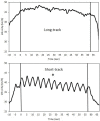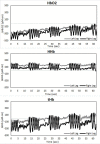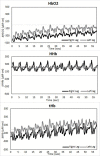Differences in Muscle Oxygenation, Perceived Fatigue and Recovery between Long-Track and Short-Track Speed Skating
- PMID: 28018244
- PMCID: PMC5156719
- DOI: 10.3389/fphys.2016.00619
Differences in Muscle Oxygenation, Perceived Fatigue and Recovery between Long-Track and Short-Track Speed Skating
Abstract
Due to the technical nature of speed skating, that is affecting physiological mechanisms such as oxygenation and blood flow, this sport provides a unique setting allowing us to uncover novel mechanistic insights of the physiological response to exercise in elite middle-distance and endurance sports. The present study aimed to examine the influence of skating mode (short-track vs. long-track) on muscle oxygenation, perceived fatigue, and recovery in elite speed skating. Muscle oxygenation of 12 talented short-track speed skaters was continuously monitored during a long-track (LT) and a short-track (ST) skating time-trial of maximal effort using near-infrared spectroscopy (NIRS) on the m. vastus lateralis for both legs. Video captures were made of each testing session for further interpretation of the muscle oxygenation. To determine recovery, perceived exertion was measured 2 and 4 h after each testing sessions. Repeated measures ANOVA's were used for statistical analysis (p < 0.05). After a rapid desaturation in both legs directly after the start, an asymmetry in muscle oxygenation between both legs was found during LT (tissue saturation-index (TSI%)-slope: left = 0.053 ± 0.032; right = 0.023 ± 0.020, p < 0.05) and ST speed skating (TSI%-slope: left = 0.050 ± 0.052, right = 0.001 ± 0.053, p < 0.05). Resaturation of the right leg was relatively lower in ST compared to LT. For the left leg, no difference was found between skating modes in muscle oxygenation. Respectively, two (ST = 5.8 ± 2.0; LT = 4.2 ± 1.5) and 4 h (ST = 4.6 ± 1.9; LT = 3.1 ± 1.6) after the time-trials, a higher rate of perceived exertion was found for ST. Based on our results, ST seems more physiologically demanding, and longer periods of recovery are needed after training compared to LT. Technical aspects unique to the exercise mode seem to impact on oxygenation, affecting processes related to the regulation of exercise intensity such as fatigue and recovery.
Keywords: elite athletes; endurance; near-infrared spectroscopy; training; winter sport.
Figures









Similar articles
-
Asymmetry of quadriceps muscle oxygenation during elite short-track speed skating.Med Sci Sports Exerc. 2012 Mar;44(3):501-8. doi: 10.1249/MSS.0b013e31822f8942. Med Sci Sports Exerc. 2012. PMID: 21900848
-
Effect of race distance on muscle oxygenation in short-track speed skating.Med Sci Sports Exerc. 2013 Jan;45(1):83-92. doi: 10.1249/MSS.0b013e31826c58dd. Med Sci Sports Exerc. 2013. PMID: 22895375
-
Effects of inspiratory muscle warm-up on locomotor muscle oxygenation in elite speed skaters during 3000 m time trials.Eur J Appl Physiol. 2019 Jan;119(1):191-200. doi: 10.1007/s00421-018-4015-8. Epub 2018 Oct 22. Eur J Appl Physiol. 2019. PMID: 30350154 Clinical Trial.
-
Performance characteristics of long-track speed skaters: a literature review.Sports Med. 2015 Apr;45(4):505-16. doi: 10.1007/s40279-014-0298-z. Sports Med. 2015. PMID: 25547998 Review.
-
Epidemiology, etiology and prevention of injuries in competitive ice speed skating-limited current evidence, multiple future priorities: A scoping review.Scand J Med Sci Sports. 2024 Apr;34(4):e14614. doi: 10.1111/sms.14614. Scand J Med Sci Sports. 2024. PMID: 38610079
Cited by
-
Muscle Oximetry in Sports Science: A Systematic Review.Sports Med. 2018 Mar;48(3):597-616. doi: 10.1007/s40279-017-0820-1. Sports Med. 2018. PMID: 29177977
-
Myoelectric, Myo-Oxygenation, and Myotonometry Changes during Robot-Assisted Bilateral Arm Exercises with Varying Resistances.Sensors (Basel). 2024 Feb 6;24(4):1061. doi: 10.3390/s24041061. Sensors (Basel). 2024. PMID: 38400219 Free PMC article.
-
Optimizing Recovery Strategies in Elite Speedskating: A Comparative Analysis of Different Modalities.J Funct Morphol Kinesiol. 2025 Jan 16;10(1):34. doi: 10.3390/jfmk10010034. J Funct Morphol Kinesiol. 2025. PMID: 39846675 Free PMC article.
-
Usefulness of Portable Device to Establish Differences in Muscle Oxygenation Between the Wingate Test and Graded Exercise Test: Effect of Gender on Anaerobic and Aerobic Capacity in Speed Skaters.Front Physiol. 2022 Mar 8;13:809864. doi: 10.3389/fphys.2022.809864. eCollection 2022. Front Physiol. 2022. PMID: 35350695 Free PMC article.
-
Combining Chronic Ischemic Preconditioning and Inspiratory Muscle Warm-Up to Enhance On-Ice Time-Trial Performance in Elite Speed Skaters.Front Physiol. 2018 Jul 31;9:1036. doi: 10.3389/fphys.2018.01036. eCollection 2018. Front Physiol. 2018. PMID: 30108521 Free PMC article.
References
-
- Borg G. (1998). Borg's Perceived Exertion and Pain Scales. Champaign, IL: Human Kinetics.
-
- De Boer R. W., Ettema G. J., Faessen B. G., Krekels H., Hollander A. P., De Groot G., et al. . (1987). Specific characteristics of speed skating: implications for summer training. Med. Sci. Sports Exerc. 19, 504–510. - PubMed
-
- De Koning J. J., Bakker F., De Groot G., Van Ingen Schenau G. J. (1994). Longitudinal development of young talented speed skaters: physiological and anthropometric aspects. J. Appl. Physiol. 77, 2311–2317. - PubMed
LinkOut - more resources
Full Text Sources
Other Literature Sources

